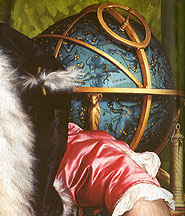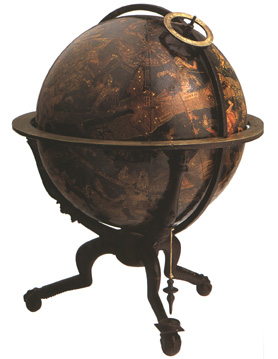
CELESTIAL GLOBE

The globe shows the constellations in the form of their eponymous mythological beings. Note the prominent position of the constellation Cygnus here marked as "GALACIA." The distinct cock-like form of the constellation and the name adapts the globe to the perspective of Dinteville and de Selve.
The latitude the globe is set for is not London's (51 1/2 degrees). Instead it is set for between 42 and 43 degrees, which corresponds to Spain or Italy. This discrepancy is perhaps connected to other "mistakes" included in the painting like the polyhedral sundial and the lute with a broken string. These can be seen as a reference to the limitations of human science which is limited by the finite nature of humanity.
Dekker and Lippincott, in their study of the instruments in the painting (Journal of the Warburg and Courtauld Institutes, 62 (1999), p. 106), observe that sixteenth century astronomical tables list the lattitude of Rome as 42 degrees north. This might be intended to hint at the differences in the political and religious points of view between London and Rome.
The globe is very close to one made by the Nuremberg astronomer Johannes Schöner in 1533. Schöner's globe is in the Science Museum in London:
